Introduction
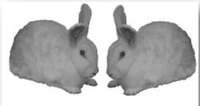 Rabbits are animals for folks that like to eat meat and want to raise it quickly. Rabbits reproduce quickly; up to eight bunnies every three months. A young rabbit can weigh four pounds in three months -- bigger than a broiler chicken. Rabbits are easy to raise, both in urban and rural areas. They don’t take up much space. Rabbits are a popular meat in Europe, China, and the Americas. Anyone who raises rabbits will never lack for meat for their table and will realize other benefits. Have you considered raising rabbits?
Rabbits are animals for folks that like to eat meat and want to raise it quickly. Rabbits reproduce quickly; up to eight bunnies every three months. A young rabbit can weigh four pounds in three months -- bigger than a broiler chicken. Rabbits are easy to raise, both in urban and rural areas. They don’t take up much space. Rabbits are a popular meat in Europe, China, and the Americas. Anyone who raises rabbits will never lack for meat for their table and will realize other benefits. Have you considered raising rabbits?
Why Raise Rabbits?
For the Good Meat They Produce
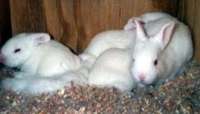
Source: ECHO Staff
Rabbit meat is good and is flavored like chicken. A three-month-old rabbit has more meat than two barnyard chickens at five months. As they are small animals, you can kill one for a meal for the family or to receive guests. You can’t do that with a goat or cow; they are too large. Those who raise rabbits never lack for meat at the table.
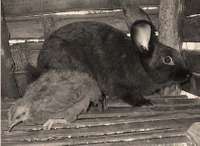
A 3-month chicken and 3-month rabbit. Source: Wayne Niles
In developed countries, doctors recommend rabbit meat to those who need to lower cholesterol. Rabbit meat is a lean, healthy meat with good protein to maintain health and rapid healing after injury or illness.
Rabbits grow quickly and have lots of offspring. A female (doe) that is well fed and cared for can produce up to 12 bunnies in one litter and have up to 6 litters a year. If you spend no money on concentrated feeds and raise your rabbit only on forage greens you can expect a rabbit to wean 6 bunnies each litter and up to 4 litters in a year. At no expense for feed a rabbit can produce up to 24 bunnies a year. If you keep two females, they will produce 48 bunnies a year. That is almost one bunny for every week of the year.
When you feed rabbits concentrated feeds such as corn, or wheat bran, they produce larger litters and the bunnies grow faster. Fed concentrates and forage, the doe will dependably produce 7 bunnies in each litter and have 5 litters a year. That is 35 bunnies a year. If you keep two female rabbits, they will produce 70 bunnies a year. That will be one a week for home consumption and 18 to sell, barter or share with friends.
Bunnies grow quickly. They double their birth weight in 6 days, and in three to four months they weigh four pounds. A family of 6 will find plenty of meat to eat when they cook a three-month-old rabbit. Rabbit meat is rich in protein, vitamins, and micro elements. Rabbits turn leaves and grass that humans can’t eat into good tasting meat we can eat.
Rabbit manure is excellent for the garden. Folks who raise rabbits in town will find a ready market for the sale for rabbit manure to flower and vegetable gardeners. Rabbit manure is richer for the garden than goat, duck, pig, or cow manure, and compost made with rabbit manure is almost as rich as commercial fertilizer and better for the garden.
For Income They Can Generate
In places where people buy rabbits for meat, you can make more money in a year with the sale of rabbits than with any other kind of animal. In Haiti, for example a three month old bunny sells for $4. If a doe produces 20 bunnies in a year those bunnies are worth $80 per year. You can’t make $80/year with a goat or cow. A young person who keeps eight female rabbits can make up to $640/year. Hence with a rabbit a young person can pay for school, books, uniform, shoes, bicycle, and more thanks to rabbits. In many places rabbits are not easily sold. Such places are ripe for the creation of new markets for rabbit products by an innovative entrepreneur.
Not Everyone Can Raise Rabbits
Folks Who Lack Discipline Can’t Raise Rabbits
Raising rabbits requires good management and discipline. Rabbits must be fed and given water every day; they don’t do well with haphazard care. If they run out of water for one day they will die. If you don’t go to the effort to collect good quality feed every day, they will get sick and likely die. If you don’t keep the cages clean, removing uneaten feed and refuse, they will die because rabbits are naturally clean animals and can’t survive in an unclean environment. Folks who are used to allowing their goats, chickens, and pigs to range freely and search for their own food, who do not even provide water for their animals, will probably not adapt well to the management required to raise rabbits. Rabbits will be a benefit to folks who are dependable, disciplined, and responsible managers of their animals.
Folks Who Cannot Easily Find Feed Can’t Raise Rabbits
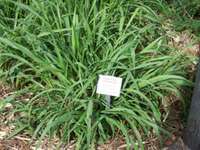
Napier or Elephant Grass is a good year- round Forage. Source: Larry Yarger
There are places that are too dry to raise rabbits because there is not enough forage available. A mother rabbit with half a dozen bunnies can consume a large sack of leaves in one day. If you have four producing rabbits, you will need to collect four sacks full of leaves, vines, grass, fruit and such every day. In places where there is winter or more than four months of dry season each year, raising rabbits on cut and carry feed alone could be hard. Most everywhere else, finding feed for rabbits should not be a problem. Even in cities, most markets have an abundant supply of waste vegetables that rabbit raisers can collect to feed their rabbits.
Folks Who Have no Place to Keep Them Can’t Raise Rabbits
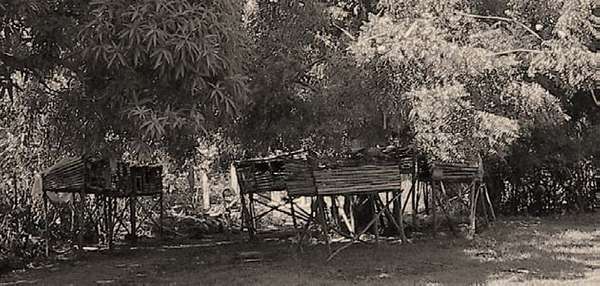
Rabbits Require Lots of Shade. Source: Wayne Niles
Rabbits need shade. The rabbit cage must be positioned so the rabbits are not exposed for long periods of direct sunlight. A mother rabbit and her bunnies need a space of about one square meter (3 feet x 3 feet). You need room for three or four cages; one for the male, one for each producing f emale, and one for weaned bunnies growing out for sale. Rabbits need to be protected from thieves, dogs, and rats; rabbits raised in an open yard may have problems with dogs and thieves. If you have a corner of the yard that is safe from thieves and dogs, has shade from the afternoon sun, and is out of the wind and rain, you can raise rabbits.
Feeding Rabbits
How Rabbits Should be Fed
Rabbits need to eat lots of fresh, green vegetative matter every day. Rabbits are nocturnal, and eat more at night. Fill the cages (mangers) with feed before the sun sets. Rabbits like fresh food. They will refuse greens that have been dried unless the rabbits have been trained to eat good quality dry hay and given plenty of water. Give them fresh feed twice a day; once in the morning and plenty at night. A nursing doe will need more feed than a pregnant doe or young buck.
A cage with a dozen young, growing rabbits that have been weaned will consume lots of feed. Here is an easy way to know if you are feeding them enough: if they eat everything, you have not given them enough; if they leave a lot, you gave them too much. The ideal is for there to be a small amount of leftover feed in the morning.
What Rabbits Eat
Rabbits eat most anything green, just like goats and cows. Here are some of the best feeds for rabbits by family: (See table at the end of the Tech Note for a full listing of rabbit forages, together with their scientific names and parts eaten.)
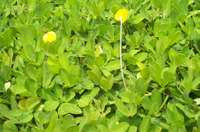
Perennial Peanut is a Nutritious Forage and makes excellent Hay. Source: ECHO Staff
Legume or Bean family: These are all kinds of plants, vines, shrubs, and trees that produce a pod that splits on a single seam. The leaves of these plants are some of the best feeds for rabbits because they are high in protein. Examples are leaves of pigeon pea, peanut, beans, cowpea, velvet bean, Stylosanthes, soybean, Leucaena, tropical kudzu, Centrosema, jack bean, forage peanut, lablab bean, Gliricidia, Sesbania, Calliandra, and Albizia.
Grass family: Rabbits eat all kinds of grasses such as guinea grass, elephant or napier grass, signal grass, maize and millet leaves.
Trees: There are many non-leguminous tree leaves rabbits will eat such as banana, mango, moringa and nacedero.
Fruit: Rabbits love fruit. Feed them all the fruit that cannot be sold or eaten by humans such as overripe bananas (with the peel), mangoes, papaya, kenép (Spanish lime), avocados, pineapple and guava.
Weeds: Lots of weeds are good feed for rabbits such as crab grass, pig weed, goose grass and Spanish needle.
Leaves of cultivated plants: Sweet potato, maize, green beans, carrot tops, cabbage, and so on. Kitchen scraps: Feed your rabbits kitchen and table scraps such as potato peels, carrots, papaya rinds, water melon rinds, avocado skins and celery leaves.
Market waste: Rabbits thrive on market waste such as waste lettuce, cabbage, carrots, apples, and other fruits and vegetables.
Garden waste: Rabbits should be fed all waste left over after the harvest from home gardens of peanut hay, green bean leaves, corn husks, cowpea and bean hulls, and unusable fruits and vegetables.
Rabbits will also eat concentrated commercial (pelleted) feeds such as those made from corn, beans, wheat and millet.
Other Principles in Feeding Rabbits
Rabbits require a variety of feed. It is not good to feed rabbits just one kind of feed for a long period of time. Always include two or three different kinds of forages in their feed. It is best to mix vines, tree leaves, plant leaves, and kitchen scraps. By offering several kinds, they get more complete nutrients in their food. What one feed lacks, another will add to the diet.
When introducing new feed to the rabbits, give it to them in small amounts for several days and observe them to make sure they can adapt to it. Once you can see that there are no adverse affects from feeding it, you can include it in your daily ration. This holds true for whatever you may feed them, whether greens, fruit, grain or concentrate.
Phytotoxins: Many forage species will have toxic factors occurring naturally that may or may not have adverse affects on rabbit health and development. They range from compounds that are mildly toxic to those that are extremely dangerous. For this reason, you should know a little about such plant chemicals.
According to Cheeke, et. al., virtually everything you will feed your rabbits is potentially poisonous (even water!) For this reason the relationship between the toxicity of the feed and the amount fed becomes very important. Biologists have said that there is a threshold level for toxins, and at concentrations below this level a toxin essentially becomes non-toxic, and some actually become important contributors to the digestive system.
Some Phytotoxins in Rabbit Feeds |
|||
|
Toxin |
Indications |
Plant Origins |
Observations |
|
Goitrogens |
Inhibit thyroxin and produce goiters |
Brassicas |
Fed in moderation goiters will not occur |
|
Gossypol |
Can cause tissue damage in some animals |
Cotton / cottonseed meal |
Feed at moderate levels (5-10% of the diet) |
|
Lectins (Hemagglutinins) |
Cause blood clotting in the digestive tract, damaging intestinal wall and reducing absorption |
Soybean, common bean, broad bean – all uncooked dry beans contain lectins |
Cook all beans before feeding; heat destroys lectins |
|
Mimosine |
Amino acid causing loss of hair |
Leucaena spp. |
Feed at no more than 10% of the diet |
|
Mycotoxins (toxic substances produced by molds growing on feeds) |
Aflatoxins cause rabbits to go off feed and water, become dehydrated, lethargic, develop liver damage and jaundice – Ergot causes blood circulation cutoff in feet, causing gangrene; may cause abortion; shuffling of feet suggesting pain Citrinin, orchratoxin, T-2 toxin, zearalenone can cause kidney, liver and reproduction problems, even death; sometimes cause enteritis Dicumarol inhibits vitamin K, causing a deficiency, spontaneous internal hemorrhaging and death |
Aflatoxins – from molds on grains and seed meal. Ergot – from seed heads of grains Citrinin, orchratoxin, T-2 toxin, zearalenone also from grains Dicumarol – from moldy clover hay |
Keep grains and seed meal dry Don’t feed grain that is discolored or deformed Keep hay clean and dry; if wet or moldy, use as mulch or compost ingredient Don’t feed grain or hay that is moldy, or that has a dusty appearance; this dust may be mold spores which can also irritate the rabbits |
|
Oxalates (Metal Chelator group) |
Bind w/ Ca2+ in the blood, causing tetany |
Amaranth, spinach, chard, beets, aroids, rhubarb, sorrel, others |
Rabbits can be fed these at moderate levels w/o problems |
|
Pyrrolizidine Alkaloids |
Cause liver damage in many animals |
Comfrey, crotalaria, tansy ragwort |
Rabbits are resistant to effects of PA |
|
Saponins |
Reduces palatability of forage (bitterness); promotes feed waste |
Leguminous forages such as alfalfa and clover |
Reduce cholesterol levels; this may be a reason rabbit meat is low in cholesterol |
|
Protease (Trypsin) Inhibitors |
Reduces protein digestibility, causes pancreas enlargement and reduced growth |
Soybean, soybean meal nd most dry beans |
Cook before feeding; heat destroys protease inhibitors |
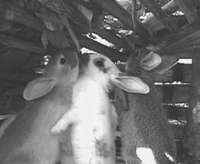
Use a Manger to keep Feed Clean. Source: Wayne Niles
Rabbits like fresh, clean feed. Do not put rabbit feed on the cage floor where the rabbits can walk and urinate on it. Feed should be placed in a manger that keeps the leaves above the rabbits, off the floor. If rabbits are allowed to trample their feed, it will wilt, be soiled and unfit for consumption. When caring for rabbits, remove the feed they have not consumed.
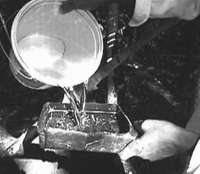
Supply Fresh Water every Day. Source: Wayne Niles
Rabbits need fresh, clean water available at all times. A nursing rabbit with six bunnies will need to drink two cola bottles of water (1.2 liters) a day. Their water must be clean. If you give them water in a bowl and they have soiled in that water, it will not be fit for drinking. It is important to clean their drinking vessels regularly. During dry season, feeds become drier and rabbits will consume more water because they are getting less from the leaves they eat. During rainy season, rabbits will consume less water.
Rabbit Cages
Protection from Wind, Rain, and Sunshine
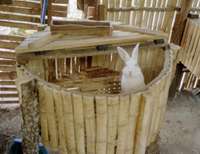
Bamboo Rabbit Hutch. Source: Larry Yarger
Rabbits cannot be allowed to run free like chickens and goats. Dogs will eat them. Rabbits must be kept in a cage or hutch to protect them from all that could cause them harm. Their cage must protect them from the sun, from wind, and from rain. It must be located in the shade, particularly shaded from the afternoon sun.
The rabbit cage must be open to allow air and light to enter freely, yet so designed that driving rains and winds do not cause the rabbits stress. The cage must be strong enough to keep dogs out and no openings large enough for rats to enter. The floor of the cage must be open to allow rabbit pellets and urine to fall through. If the floor openings are too large, their feet might get caught and the rabbits hurt themselves.
How to Make a Rabbit Cage
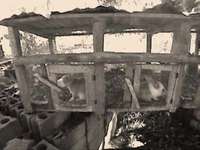
Wood and Wire Hutch. Source: Wayne Niles
You can make a cage out of anything solid: boards, bamboo, steel, metal sheet roofing, fencing, chicken wire, feed sacks and such. A mother rabbit needs a volume of 60 cm x 100 cm x 60 cm (2 ft x 3 ft x 2 ft) as a minimum. This is half an arm’s length wide and a bit less than an arm’s length deep and high. You shouldn’t make a cage so deep you can’t reach the back to clean it. You can always make a cage larger, but a cage for a mother rabbit should never be smaller than the minimum.
A cage for young weaned rabbits to grow in should be larger. For 10 weaned, growing bunnies, you need a cage 125 cm x 125 cm x 60 cm high (4ft x 4 ft x 2 ft high). A grower cage could be larger. All openings in the cage must be smaller than the littlest bunny to keep them in. (See Appendix on how to make a simple rabbit hutch.)
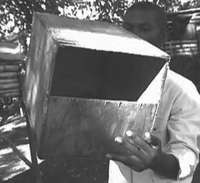
Wooden Kindling Box. Source: Wayne Niles
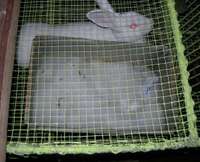
Open-Top Kindling Box. Source: Larry Yarger
The Nest or Kindling Box

Manger above Rabbits, right. Source: Wayne Niles
You need to prepare a nest box for each doe. You can make the box out of anything durable: wood, steel, clay, or plastic. The box needs to be large enough for the doe to turn around in. A typical nest box will be 30 cm x 90 cm x 30 cm (1 ft x 1 ½ ft, x 1 ft). Remember to make the door to your rabbit’s cage big enough so that you can put the nest box through it and bring it back out to clean it. Similarly, the cage needs to be big enough for the mother rabbit to move around outside the nest box once it is in place. The front of the box should have an opening so the mother can enter but the babies can’t jump out until they are 18 days old. This means about 15 cm (6 in) high. The bottom can be made of fine wire cloth but small enough so the bunnies cannot get caught in it or pass through.
Mangers, Concentrate Feeders, and Waterers
Forage. Every cage needs to have a manger to hold forage. The feed must not be allowed to fall to the cage floor where the rabbits can trample and soil it. Position the manger above the floor at a convenient height with openings so the rabbits can get at the leaves and pull them through.
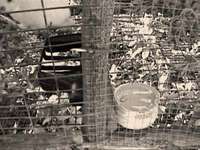
Waterers made from Plastic Containers. Source: Wayne Niles
Concentrate. If you are going to give your rabbits concentrated feeds, you will need a feeder to hold it which prevents the rabbits from climbing into it and wasting the feed. Any open vessel will do but it is best to find something the rabbits cannot turn over and spill.
Water. Every cage needs a waterer so the rabbits have access to clean drinking water. Any open vessel will do. A sardine can or plastic bottle cut open so the rabbits can get at the water is fine. Other options are a clay vessel, or a piece of bamboo or something made of cement. Commercial waterers use a ball in a tube to prevent water from spilling out while allowing the rabbits to lick the water. Another alternative is a cement cup that can support an inverted water bottle.
Avoiding Losses
Rabbits are often lost when they fall out of the cage or when dogs break in and steal them. Your cage must be solid and well built with no bunny-sized holes. When bunnies are less than two weeks old, they should stay in the nesting box, as most cages have holes big enough for
them to fall through. It is important that the nest box opening be high enough (15 cm or 6 in) that the bunnies cannot jump over it.
To protect against dogs, the cage needs to be solid with a substantial door. Suspend the cage high enough to be out of easy reach of most dogs. If dogs are a serious cause of losses, attach cans or other metallic items that will make noise when they bother the cage. Alternatively, move the rabbits inside a shed that is dog proof. Be creative in using resources available to you to protect your rabbits from rats, mongooses, ants, snakes and even humans.
Breeding Rabbits
You have to manage the breeding of your rabbits just as folks have to manage the breeding of pigs or cows. The does are nearly always in heat. It is theoretically possible to breed a rabbit the same day it kindles (gives birth), though that would not be good for the rabbit’s health. Normally, a female should be bred 30 to 40 days after kindling.
How to Tell If a Rabbit is Male or Female
You can determine the sex of a rabbit when it is more than two weeks old. To sex a rabbit, spread its legs and part the hair around the genitals. At two weeks the male genitals are round and pop up whereas female genitals are oval and attach to the body on one side. At three months, males have clearly-developed testicles and a penis presents itself when you pull back the skin.

Rabbit Genitalia: A: Young Buck, B: Adult Buck, C: Young Doe, D: Adult Doe. Source: Wayne Niles
Breeding Age
Rabbits normally do not reach sexual maturity before five months, and with a poor diet it will take longer. It is never a good practice to breed an animal before its body has grown sufficiently to handle the job of bearing offspring. It needs to have the physical strength to produce a good litter. Often litters are aborted when the doe is not physically fit to handle the pregnancy. It is in your interest to not breed them too young. A female should weigh at least 2.5 kg (5 lbs) before being bred for the first time.
How Rabbits Mate
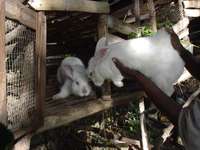
Always take the Female to the Male's Cage. Source: Wayne Niles
Your breeding male must always be kept alone in his own cage. Males that share a cage with a female will likely not be interested in mating. A male kept with a bred female will likely kill the bunnies when they are born.
When a female is ready to be bred, you take her from her cage to the male’s cage. If you bring the male to the female, she will defend her territory, fight with and sometimes kill the male. When you carry a rabbit, use two hands; NEVER carry a rabbit by its ears. Hold the front feet in one hand and the back feet in the other. A female that is mistreated will not likely come into heat.
When you present the female to the male, breeding will take place in a few seconds. When the male falls over the female is bred. If the female is not in heat, she will fight with the male. Don’t leave them together too long for they will wear each other out. Remove the female and try again the next day. Never leave a female in the male cage more than 15 minutes. To assure insemination, present the female 2-3 times; mornings and evenings are best. When she has been bred, write the date down on the data card with the name of the male (if you have several) and mark the date the bunnies are to be born – 30 days later. Rabbits give birth 28 – 32 days after breeding.
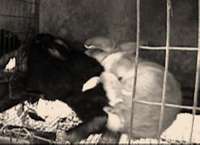
When the buck falls over, they have mated. Source: Wayne Niles
Males that are undernourished, too fat, or too old, lose heart and become poor breeders. A male not interested in breeding must be replaced. Males should be replaced every two years even when well kept. Males represent half your stock. Find males unrelated to your rabbit population to avoid inbreeding. If the male you use is an offspring of your flock, the size and health of the bunnies it produces will be poor. Inbred rabbits are weak, small, and easily fall ill. Always look for a replacement male unrelated to your flock of rabbits.
How to Determine if a Doe is Pregnant
Your rabbit will give birth 30 days after breeding. Fifteen days after breeding, you can feel the babies in her abdomen. This is called palpation. Take the female in one hand and with the other gently palpate or squeeze her abdomen high up toward her back bone. You will feel some balls the size of marbles.
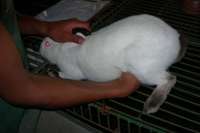
Palpating the Doe to check Pregnancy. Source: Larry Yarger
These are her young. Do this gently or you will injure the rabbit or her young. She could miscarry if you are too brutal. If you find no growing young inside, you need to breed her again. If she accepts the male, this is confirmation that she was not bred the first time.
What Prevents a Rabbit from Becoming Pregnant
A female will not easily become pregnant if:
- She is under weight
- The cage is too hot
- She is sick
- She is bred too soon after weaning the last litter
- She is undernourished
- She is too old (more than 3 years)
To avoid rabbits not getting bred the first time, feed them well, don’t breed them too often, situate their cages out of the sun, rain, and wind, and finally, change your males every two years to keep your flock young and productive.
Care of the Nest or Kindling Box
Have a nest box for each bred female. Clean the box and wash it in Clorox to sterilize the walls and floor before reusing it. Introduce the box into her cage two or three days before she is to give birth. Around this time you will hear the doe scratching the floor trying to dig a hole to nest in. Soon after you put the nest box in, she will pull fur from her chest area to prepare the nest.
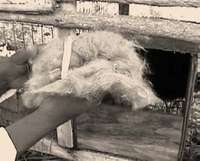
Keep extra Fur on Hand for Nest Boxes. Source: Wayne Niles
When a doe pulls her fur, she will be kindling that day or the next. Some poor quality does do not use the nest box and give birth on the cage floor. Such does you must get rid of. Don’t disturb the doe while kindling. When she is finished she will exit the box. Then you must count the bunnies and remove those stillborn. Mark the date and number of live bunnies born on the data card. If the nest does not have much fur, add from a stock you keep on hand for that purpose. If ants are a problem, powder the nest with insecticide or set the cage legs in cans of oil. Ants are the most danger to newborn bunnies.
The number of bunnies born is a characteristic of the breed. Some breeds regularly produce 4 to 6 bunnies, others 6 to 12. Undernourished does produce fewer young as do does subjected to stress. Stress means they were too hot, too cold, too hungry, too thirsty, or made to suffer in some manner.
If you have several producing rabbits, breed them on the same day so they kindle the same day. That way if one produces eight bunnies, while the other only four, you can balance the ‘load’ by give two from the litter of eight to the litter of four. This way they may all be weaned successfully.
How Rabbits Nurse Their Young
You will rarely see a rabbit nurse their young. In the wild, females minimize the time they are in or around their nests. Rabbits nurse briefly to reduce the possibility of predators finding the nest. Rabbit milk is highly concentrated so the babies need not drink a lot for them to grow quickly. The best way to see if a doe is nursing is by feeling that the bellies of the bunnies are full and they are growing. You cannot force a mother to nurse. If all the bunnies die, give the female one more chance. Often when a doe does not nurse, it is your fault for not feeding her adequately or due to some other stress. A nursing doe needs much more feed and plenty of water than she normally does. She will more likely wean all her bunnies if you feed her concentrates in addition to her normal forage. Rabbits normally loose one or two of their young unless they are well fed. Rabbits fed vegetative matter only generally do not wean all the bunnies successfully; some die.
When the Bunnies are Ready to be Weaned
Remove the nest box when all the bunnies can get out on their own. The higher the door on the nest, the longer it will take for them to be able to get out. Set the door high enough so they stay in 3 weeks. One of the highest losses of bunnies is when they get out of the nesting box too young and fall out of a cage not made to handle such small bunnies.
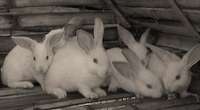
Six weaning rabbits. Source: Wayne Niles
Bunnies should be weaned by 4 to 8 weeks. At that point they should be moved to another cage to give the mother a rest. By 3 weeks of age they can begin eating vegetative matter. You can breed the mother the same day you wean the bunnies. Some producers breed her when the bunnies are 6 weeks old and wean the bunnies at 8 weeks. Thus the bunnies are possibly nursing the same time the mother is pregnant. A doe under such conditions must be very well fed so not to miscarry.
At weaning, select a particularly strong doe from among the young bunnies to replace the mother the next year. Always select the strongest, fastest growing bunnies to replace and improve your producing stock. You can replace your female stock with your own production but you must always replace your male with a stock unrelated to yours to avoid inbreeding.
Young weaned bunnies may grow together in the same cage until they are 5 months old. After that, they must be separated as the bucks will become sexually active. They will fight each other and mate with their siblings. You should eat or sell them before they reach that age.
Eat or Sell Poor Performing Females
Some does are not good mothers. These do not use the nest box or have lots of still born young. Such rabbits should be sold for meat. Do not sell them to someone wishing to raise rabbits. Other rabbits may be difficult to impregnate. If you breed a rabbit several times and it never gets pregnant, you should sell or eat it. Others may not be good at nursing their young. They consistently have six to eight babies but most die before reaching weaning age. Again, such mothers should not be kept.
These problems are sometimes the owner’s and not the rabbits’ fault. If several of your rabbits have difficulty getting pregnant or nursing their young, the problem could be poor management such as poor quality feed, insufficient feed, unbalanced nutrition, lack of water, excessive heat and so on. Remember, a pregnant or nursing doe needs much more feed than the others.
Rabbit Diseases
Well cared for rabbits are almost never sick. Chickens and other domesticated animals have far more disease problems in contrast to rabbits. When a rabbit becomes ill, it is a sign that it has been stressed or mismanaged. Causes of disease are:
- Insufficient feed or water
- Poor quality feed, or lack of variety in feed
- Poor cage construction exposing them to heat, wind, rain, rats or dogs
- Poor cage sanitation; infrequent cage cleaning
- Over production – bred too frequently without adequate nutrition or rest periods
How do you know when a rabbit is sick? The first sign is when it stops eating. Another sign is when the rabbit acts depressed and does not move around the cage much. You should examine the rabbit to see what the problem is. Often it’s an infection of the foot or teat or other body part. An infection will give the rabbit a fever and it will feel hotter than usual.
When a rabbit is sick, separate it from the others so the disease does not spread. If the problem is indeed an infection, give it ampicillin or penicillin. You can put the antibiotic in its drinking water or in the feed concentrate. Give just a small amount. A 500 mg pill should be enough for six doses, put a little in the water each day.
Ear mites are a common problem in rabbits. Ear mites are like tiny spiders that live on secretions in the ear. The ear fills with a hard crusty material and the rabbit is constantly shaking its head. Ear mites are easy to get rid of. Pour a tiny amount of cooking oil down each ear and hold the rabbits head a while to help the oil soak in. Oil smothers the mites. In a day or two the ears will be clean.
Other than ear mites or infections, most other causes of rabbit illness or death are from poor care. If you find dead weaned bunnies in a cage you probably have not been feeding them well or they lack water. Rabbits are not tolerant of negligence. To succeed with rabbits you have to be a good manager.
Dressing Rabbits
Rabbits can be easily and humanely killed with a karate chop to the neck. Hold them by the back feet and hit the back of the neck with the side of your hand. This will break the neck and spinal cord instantly. Then suspend the rabbit by its hind legs for skinning and cleaning with its belly facing towards you.
Begin skinning by cutting the skin around each foot and pulling down. Cut carefully around the anus until it is completely free of the skin and supporting tissues. Continue to cut the skin in a line down to the neck then pull and remove all the skin like a shirt. Cut the skin away from the front paws to remove it completely.
Next cut open the abdomen beginning near the anus cutting down to the chest. Remove the intestines, lungs, heart, and liver. Be careful not to rupture the gall bladder. This will ruin the meat. Once you have removed the guts, remove the head and legs leaving only good meat. The rabbit is ready to be cooked. Rabbits can be prepared as you would chicken.
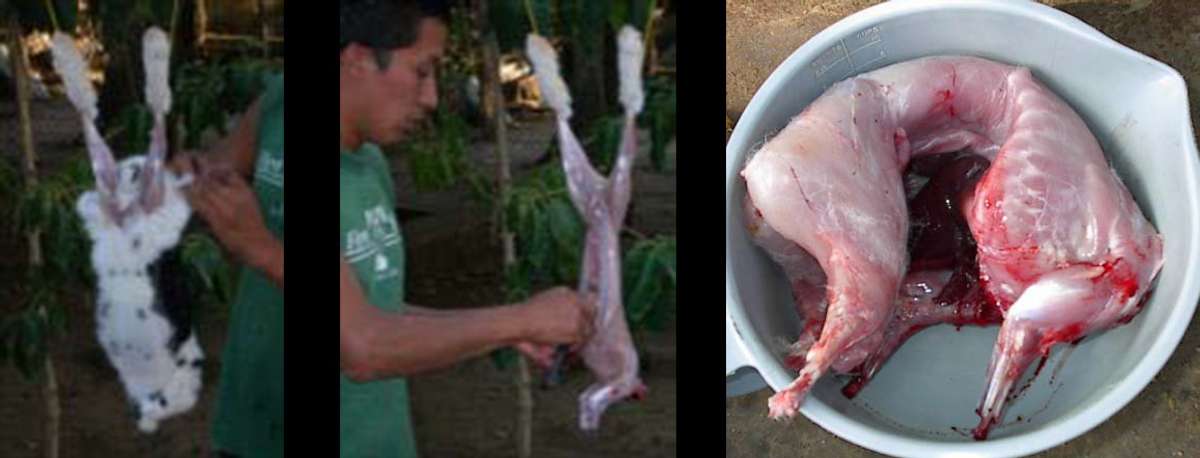
Sources: Larry Yarger and Wayne Niles
Keeping Rabbits Teaches Good Management
Good Management Requires Effort and Discipline
Rabbits take more care than any other animal. But they can also produce more meat in a year than any other animal. To be a good rabbit producer there are things you must do every day, every week, and every month.
Every Morning
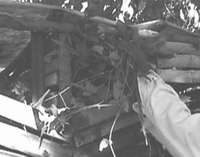
Always Feed PLENTY of Fresh Greens. Source: Wayne Niles
Each morning you must change the feed and water in each cage. Remove the old, dry feed, and replace with fresh. Throw out the stale water and replace it with fresh. Then clean the cages. Remove scraps and trampled feed. Rabbits are clean animals and always relieve themselves in the same corner of the cage. If trash accumulates in the cage, their waste will not fall through the floor.
If you delegate rabbit care to a child you will probably not succeed in raising rabbits because children lack the discipline to care for them. Care of the cages each morning should be done by an adult. During these operations you should notice the health of the bunnies and the rabbits and take actions as needed.
Every Evening
Every evening give them more feed. Do not remove that which remains from the morning. Remember rabbits eat more at night than during the day. Make sure they have fresh water also.
Every Week
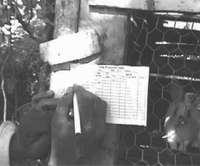
Keep Good Records! Record every mating, birth and weaning. Source: Wayne Niles
Once a week you need to clean below the cages to remove all waste that has accumulated. This is excellent material for composting or adding directly to the garden. Do not allow waste to accumulate below the cages for more than a week or the area will begin to smell and breed flies. Once a week it is good to wash all waterers with soap or bleach to kill algae that may be growing in them.
Production Records
A good manager keeps careful production records. You should make notes of the date bred, offspring born, offspring weaned and name of male parent of each litter. The parent lines of the mother rabbits should be known to prevent inbreeding. Each mother rabbit kept for production should have a name or identification number. There are ways also to mark your rabbits. Easiest is to cut a notch in an ear. Alternatively you can tattoo their ears with a needle and ink. You don’t have to mark them, in which case you should be able to recognize them by sight.
Record Card for a Female Producer:
Below is a typical record sheet (data card) for rabbit production:
|
Name: White |
DOB: 8 Sep 2012 |
Father: Grey White |
Mother: Black eyes |
||||
|
Name of Male |
Date Bred |
Date Gave Birth |
Number of living offspring |
Weaned |
|||
|
Date weaned |
# (Total) |
Remareks |
# Females |
||||
|
Brown |
10 June |
11 July |
6 |
30 August |
5 |
2 |
|
|
Brown |
30 August |
28 September |
7 |
15 November |
6 |
treated young for ear mites |
4 |
|
Brown |
15 November |
Open |
|||||
|
Brown |
30 November |
30 December |
6 |
15 February |
6 |
3 |
|
When you breed a rabbit, write the date and name of the male. If she becomes pregnant, write the date she gives birth and the number of live babies. When they are weaned, note the date, quantity weaned, and number of females. All this information helps you manage your production. If you forget the date you bred the rabbit, you may forget to put in a nest box and the babies will be born in the cage and likely lost. With these records you can easily see which female produces the most young, is most consistently pregnant and is a good nursing and weaning mother. Such a mother you want to keep as well as her best daughters. On the other hand these records help you note the poor mothers that produce few live young, are difficult to get pregnant and are poor at nursing and weaning.
Folks Who Can Raise Rabbits Succeed In Other Endeavors
Not everyone has the diligence to successfully raise rabbits. Those who can are more likely to succeed in other things they try to do. Raising rabbits requires discipline and good management practices in several areas:
- Management of the environment: Cleaning in and around cages
- Management of nutrition: supplying an adequate and wholesome diet for the rabbits
- Management of health: watching for disease and responding appropriately to it.
- Management of reproduction: breeding the rabbits to maintain a steady supply of bunnies.
- Management of genetics: seeking males unrelated to the flock to avoid inbreeding.
Anyone who can perform these management skills well, without cutting corners will likely succeed in raising rabbits. His or her family will never lack for wholesome meat to eat!
Appendix I
Some Common Rabbit Forages
Some Common Rabbit Forages |
||
|
Scientific Name(s) |
Common Name(s) |
Plant Type (Part Fed) |
|
Amaranthus retroflexus |
Red-root pigweed |
Forb weed (leaves, stems) |
|
Amaranthus spinosus |
Spiny amaranth |
Forb weed (leaves, stems) |
|
Ananas comosus |
Pineapple |
Forb (fruit cores) |
|
Arachis hypogaea |
Peanut, groundnut |
Forb legume (leaves, stem, seed cake) |
|
Arachis pintoi |
||
|
A. glabrata |
Forage peanut, perennial peanut |
Forb legume (leaves, stem) |
|
Avena spp. |
Oats |
Grass (stalk, leaves, grain) |
|
Beta vulgaris subsp. cicla var. flavescens |
Chard, Swiss Chard |
Forb (leaves) |
|
Beta vulgaris subsp. vulgaris |
Beet |
Root (root, leaves) |
|
Bidens pilosa, B. alba, B. bipinnata |
Spanish needles |
Forb weed (leaves, stems) |
|
Boehmeria nivea |
Ramie |
Forb (leaves) |
|
Brassica napus var. napus |
Rape, Canola |
Forb (leaves, seed meal) |
|
Brassica spp. |
Turnip, cabbage, cauliflower, kale, mustard |
Forb (leaves, root, stems, flowers) |
|
Cajanus cajan |
Pigeon pea |
Shrub legume (leaves, pods) |
|
Calliandra calothyrsus |
Calliandra |
Tree legume (leaves) |
|
Canavalia ensiformis |
Jack bean |
Forb legume (leaves) |
|
Canavalia gladiata |
Sword bean |
Forb legume (leaves) |
|
Carica papaya |
Papaya |
Tree (ripe fruit, leaves) |
|
Carthamus tinctorius |
Safflower |
Forb (leaves, stem) |
|
Centrosema pubescens |
Centro |
Forb legume vine (leaves, stems) |
|
Clitoria ternatea |
Butterfly pea |
Forb, legume (leaves) |
|
Cynodon dactylon var. dactylon |
Bermuda or Bahama Grass |
Grass (leaves, stems) |
|
Daucus carota |
Carrot |
Root (root, leaves) |
|
Diphysa americana |
Guachipilín |
Tree (leaves) |
|
Erythrina berteroana |
Coral-bean, Pito |
Tree (leaves) |
|
Fagopyrum esculentum |
Buckwheat |
Forb (leaves, grain) |
|
Gliricidia sepium |
Quick stick, Madre de cacao |
Tree legume (leaves) |
|
Glycine max |
Soybean, soya |
Forb legume (leaves, pods, grain, meal, seed cake) |
|
Gossypium spp. |
Cotton |
Shrub (seed meal) |
|
Guazuma ulmifolia |
Guácimo |
Tree (leaves) |
|
Helianthus annuus |
Sunflower |
Forb (grain, seed cake) |
|
Hibiscus rosa-sinensis |
Chinese hibiscus |
Shrub (leaves) |
|
Hordeum vulgare subsp. vulgare |
Barley |
Grass (grain) |
|
Ipomoea aquatica |
Kang kong, water spinach |
Forb crop (leaves, stems) |
|
Ipomoea batatas |
Sweet potato |
Forb vine (leaves, stem) |
|
Lactuca sativa |
Lettuce |
Forb crop (leaves) |
|
Leucaena diversifolia |
Acid tolerant Ipil Ipil |
Tree legume (leaves) – feed only 10% of diet |
|
Leucaena leucocephala |
Leucina, Ipil Ipil |
Tree legume (leaves) – feed only 10% of diet |
|
Malus domestica |
Apple |
Tree (fruit – NOT seeds) |
|
Mangifera indica |
Mango |
Tree (leaves, ripe fruit) |
|
Many species |
Palm |
Tree (leaves, palm kernel cake) |
|
Many species |
Vetch |
Forb legume (leaves, stem) |
|
Many species |
Clover |
Forb legume (leaves, stems, flowers) |
|
Medicago sativa subsp. sativa |
Alfalfa |
Forb legume (leaves, stems) |
|
Melicoccus bijugatus |
Kenép, Spanish lime |
Tree (ripe fruit) |
|
Moringa oleifera |
Moringa, Drumstick Tree |
Tree (leaves, flowers) |
|
Morus spp. |
Mulberry |
Tree (leaves, fruit) |
|
Mucuna pruriens |
Velvet bean |
Forb legume vine (leaves) |
|
Musa x paradisiaca |
||
|
M. acuminata |
Banana, Plantain |
Forb (leaves, fruit w/ peel) |
|
Oryza sativa |
Rice |
Grass (leaves, stalk, grain, meal, bran) |
|
Pastinaca sativa subsp. sativa |
Parsnip |
Root (leaves, root) |
|
Pennisetum purpureum |
Napier, elephant grass |
Grass (leaves, stalk) |
|
Phaseolus vulgaris |
Snap or green beans |
Forb legume (leaves, pods) |
|
Pisum sativum var. sativum |
Pea, Garden Pea |
Forb legume (leaves, pods) |
|
Pueraria phaseoloides var. phaseoloides, P. phaseoloides var. javanica |
Tropical kudzu |
Forb legume vine (leaves, stems) |
|
Quercus spp. |
Oak |
Tree (leaves) |
|
Robinia pseudoacacia |
Black locust |
Tree legume (leaves) |
|
Saccharum officinarum |
Sugarcane |
Grass (leaves, stalk) |
|
Salix spp. |
Willow |
Tree (leaves) |
|
Sassafras albidum |
Sassafras |
Tree (bark) |
|
Secale cereal subsp. cereal |
Rye |
Grass (leaves, stalk, grain) |
|
Senna tora |
Sickle senna |
Tree legume (leaves, pods) |
|
Setaria italic, Echinochloa esculenta, Pennisetum glaucum, Panicum miliaceum subsp. miliaceum |
Millet, foxtail or Italian, Millet, Japanese Millet, pearl, Millet, proso |
Grass (leaves, grain, meal, bran) |
|
Sorghum bicolor |
Sorghum |
Grass (leaves, grain, meal, bran) |
|
Stylosanthes spp. |
Stylo |
Forb legume (leaves, stems) |
|
Symphytum officinale |
Comfrey, common comfrey |
Forb (leaves) |
|
Talinum triangulare |
Talinum, Philippine spinach |
Forb (leaves, stem) |
|
Taraxacum officinale |
Dandelion |
Forb (leaves, petiole, flower) |
|
Telfairia occidentalis |
Telfairia, fluted gourd, oysternut |
Forb vine (leaves, stem) |
|
Tithonia rotundifolia |
Mexican sunflower |
Forb (leaves) |
|
Trichantera gigantea |
Nacedero |
Tree (leaves) |
|
Triticum aestivum |
Wheat |
Grass (straw, leaves, grain) |
|
Urochloa maxima |
Guinea grass |
Grass (leaves) |
|
Urochloa mutica |
Para Grass |
Grass (leaves) |
|
Vigna radiata |
Mung bean |
Forb legume (leaves, pods) |
|
Vigna unguiculata |
Cowpea |
Forb legume (leaves, pods) |
|
Zea mays |
Maize, corn |
Grass (leaves, grain, meal, bran, sprouted grain) |
|
In general, rabbits can safely eat any fruit, vegetable or herb that people would eat. There is some concern that due to higher sugar content in fruit, it may cause diarrhea, so it is recommended they be given in moderation and slowly over time if they’re not accustomed to it. |
||
|
Sprouted Grain. At ECHO we have been experimenting with feeding sprouted maize (Zea mays) as a forage option for rabbits. The grain is soaked overnight in water to soften the grain and initiate germination. After 24hours the water is drained and the grain allowed to fully germinate. With cooler temperatures, the grain doesn’t always send up the cotyledon or seed leaf. However, even with just the emerging radical (root) the rabbits readily eat the grain, shoots, roots and all. The records show that the rabbits fed sprouted maize start out on a par with those fed commercial pellets, but each week draw further behind on weight gained. They are also fed forage. |
||
Appendix II
Some Plants with Toxic Factors
Some Plants with Toxic Factors to Consider for Rabbits |
||
|
Scientific Name (s) |
Common Name(s) |
Observations |
|
Abrus precatorius |
Rosary pea, crab eye bean |
All parts of plant are toxic; red/black seeds are fatal |
|
Acacia berlandieri |
Guajillo |
All parts toxic to rabbits, although is used as forage |
|
Achillea millefolium |
Yarrow |
May cause skin irritations |
|
Agave spp. |
Agave, yucca, lechuguilla |
Leaves toxic |
|
Aleurites fordii |
Tung oil tree |
All parts toxic |
|
Aloe vera |
Aloe, true aloe |
The juice of the aloe plant is toxic, this and other species, as well |
|
Amaranthus spp. |
Amaranth |
Leaves and stems contain oxalates; feed at moderate levels |
|
Araceae family |
Monstera, taro, philodendron, pothos, jack-in-the-pulpit, may apple, caladium, dieffenbachia (dumb cane), elephant’s ear, anthurium, peace lily |
All plants of the Araceae (arum or aroid family) are toxic. Leaves, stems, flowers and fruits carry oxalates which can be fatal in large quantities. |
|
Areca catechu |
Areca palm, Betel nut palm |
All parts are toxic |
|
Asclepias spp. (especially A. eriocarpa) |
Milkweed (esp. Indian or woolly-pod milkweed) |
All parts toxic; can cause “head-down” disease (paralysis); if fed dry hay, milkweed can often be found in the hay |
|
Astragalus spp. |
Milk vetch |
All parts toxic |
|
Beta vulgaris subsp. Cicla var. flavescens |
Chard, Swiss Chard |
Leaves contain oxalates; feed in moderate amounts |
|
Brassicaceae (mustard family) |
Cole crops, brassicas, mustards, crucifers |
All parts mildly toxic; contain goitrogens; feed small amounts |
|
Brunfelsia spp. |
Yesterday, today and tomorrow |
All parts toxic; some are hallucinogenic |
|
Caesalpinia gilliesii |
Bird of paradise |
Green seeds, pods toxic |
|
Calendula officinalis |
Calendula, pot marigold |
All parts toxic to rabbits |
|
Cannabis sativa |
Hemp, marijuana |
Flowers, leaves, stems toxic |
|
Colocasia esculenta |
Taro, Dasheen |
Leaves, petioles toxic (contain oxalates) |
|
Crotalaria spp. |
Crotalaria, rattlebox |
Most Crotalaria spp. are toxic-the whole plant; contain pyrrolizidine alkaloids |
|
Dracaena spp. |
Dracaena |
All parts toxic |
|
Euphorbia pulcherrima |
Poinsettia |
All parts are toxic; leaves, sap are fatal |
|
Euphorbia spp. |
Spurge |
Leaves, flowers, sap toxic |
|
Euphorbiaceae (spurge family) |
Candelabra cactus, pencil plant, jatropha, cassava, castor bean, crown of thorns, cypress spurge, gopher spurge |
Most euphorbs (of the Euphorbiaceae or spurge family are toxic, usually with a toxic milky sap, and should be avoided |
|
Ficus spp. |
Laurel, fig, Indian rubber |
Plants of the genus Ficus in the Moraceae or mulberry family should be avoided; they carry a toxin in the milky sap common to the family |
|
Glycine max |
Soy bean |
Grain contains trypsin inhibitors which reduce digestibility and should be cooked before feeding |
|
Gossypium spp. |
Cotton |
Seed meal contains gossypol; feed at 5-10% of diet |
|
Hedera helix |
English ivy |
Leaves and berries toxic |
|
Impatiens balsamina |
Bush balsam, impatiens |
Although edible for humans, all Impatiens spp. are toxic to rabbits |
|
Ipomoea violacea |
Morning glory |
All parts toxic (though other Ipomoea spp. are good feed!) |
|
Jatropha curcas |
Jatropha, purge nut |
Seeds and leaves are toxic |
|
Lantana camara |
lantana |
All parts of lantana are toxic; the green berries are fatal |
|
Leucaena spp. |
Leucaena, Ipil Ipil |
High mimosine concentration in leaves; feed only 10% of diet; may have depilatory affect in rabbits |
|
Liliaceae (Lily family), Alliaceae (Onion family), Amaryllidaceae (amaryllis) |
All bulbing plants, including onion, garlic, amaryllis, daffodil, tulip |
Don’t feed bulbs to rabbits |
|
Lycopersicon esculentum |
Tomato |
Leaves, stems toxic |
|
Maclura pomifera |
Osage orange |
Fruit (hedge apples) are toxic |
|
Malus domestica |
Apple |
Seeds contain cyanide, but fruit is a good feed |
|
Manihot esculenta |
Cassava, manioc, yuca |
Roots, sap toxic |
|
Melia azedarach |
Chinaberry tree |
Fruits toxic |
|
Monstera deliciosa |
Ceriman, monstera |
All parts toxic w/ oxalates |
|
Nandina domestica |
Heavenly bamboo |
Leaves toxic |
|
Nerium oleander |
Oleander |
Leaves, branches, flowers, nectar toxic (to humans, too!) |
|
Oxalis spp. |
Oxalis, sorrel, shamrock |
Contain oxalates |
|
Pachyrhizus erosus |
Yam bean, Jícama |
Leaves, immature pods toxic |
|
Papaver somniferum |
Opium poppy |
Plant juices are toxic |
|
Parthenocissus quinquefolia |
Virginia creeper |
Leaves and unripe fruit toxic |
|
Pastinaca sativa subsp. sylvestris |
Wild Parsnip |
All parts toxic |
|
Perilla frutescens |
Perilla |
All parts toxic to rabbits |
|
Persea americana |
Avocado |
Leaves toxic; fruit & peel good feed |
|
Phaseolus spp. |
Dry beans, lima beans |
Dry beans should be cooked before feeding to rabbits; contain trypsin inhibitors and lectins which are destroyed by heating |
|
Prunus |
Apricot |
Seeds (pits) contain cyanide, but fruit is a good feed |
|
Prunus persica |
Peach |
Seeds (pits), twigs, leaves contain cyanide, but fruit is a good feed |
|
Pyrus communis |
Pear |
Seeds contain cyanide, but fruit is a good feed |
|
Quercus spp. |
Oaks |
Leaves and acorns are toxic |
|
Rheum x hybridum |
Rhubarb |
Leaves contain oxalates; can be fatal; feed in moderate amounts |
|
Ricinus comunis |
Castor (bean) |
Seed and leaves toxic |
|
Robinia pseudoacacia |
Black locust |
Bark, sprouts & foliage are toxic |
|
Rosmarinus spp. |
Rosemary |
Leaves of some are toxic |
|
Rumex acetosa |
Garden sorrel |
Contains oxalates |
|
Sesbania drummondii |
Poison bean, rattlebox |
All parts toxic |
|
Sesbania punicea |
Red sesbania |
All parts toxic |
|
Sesbania vesicaria |
Bladderpod |
All parts toxic |
|
Solanaceae (nightshade family) |
Tomato, pepper, eggplant, angel trumpet, nightshade, tobacco, night-blooming jasmine, four o’clock, Jerusalem cherry |
Most stems, roots, leaves and UNRIPE fruit are toxic to rabbits |
|
Sorghum bicolor |
Sorghum, broomcorn, |
|
|
Sorghum x drummondii |
Sudan grass |
|
|
Tagetes spp. |
Marigold |
May cause skin irritation |
|
Tanacetum vulgare |
Tansy |
All parts toxic |
|
Toxicodendron radicans Toxicodendron pubescens Toxicodendron diversilobum Toxicodendron vernix |
Poison ivy Eastern poison oak Western poison oak Poison sumac |
All parts are toxic |
|
Trifolium hybridum |
Alsike clover |
All parts toxic |
|
Viburnum spp. |
Viburnum |
Berries and leaves mildly toxic |
|
Vicia fava |
Broad bean, fava bean |
Dry beans should be cooked before feeding to rabbits; contain trypsin inhibitors and lectins which are destroyed by heating |
|
NOTE: Toxins occur in most feeds; the important thing is to learn the correct amount to feed without adverse effects. When trying a new plant, feed it in small amounts for several days without varying the rest of the diet to see if there are adverse responses or reactions before making it a regular part of the diet. |
||
|
Additionally, this list is not exhaustive. If you have questions about a certain plant and its toxic potential, follow the instructions above, or reach out to local experts who may know. |
||
Appendix III
How to Make an Inexpensive Rabbit Hutch out of Local Materials

 Photos in Appendix III by Wayne Niles
Photos in Appendix III by Wayne Niles
Special thanks for assistance goes to Mèt Jacques Saintilus, Ewaldy, Fandieu, Madame Grimard Abel, Ms Jane Volker, and others.
Some Useful References
The Rabbit Project Manual, a Trainer’s Manual for Meat Rabbit Project Development, by S.D. Lukefahr, Heifer Project International, 1992, 103 pp.
The Homesteader’s Guide to Raising Small Livestock, by J.D. Belanger, Rodale Press Inc. Book Division, 1974, pp. 10-62.
Back-Yard Rabbit Keeping in the Tropics (Agrodok Series #20), by J.B. Schiere & C.J. Corstiaensen, AGROMISA and CTA, the Netherlands, 2008, 74 pp.
Raising Healthy Rabbits under Primitive Conditions, by Dr. W.S. Bivin & Dr. W.W. King, Christian Veterinary Missions, Division of World Concern, 108 pp.
Rabbits (in the Tropical Agriculturalist Series), D. Fielding & Dr. G. Matheron, CTA and MacMillan Press Ltd., 1993, 106 pp.
Rabbit Production, by P.R. Cheeke, N.P. Patton & G.S. Templeton, The Interstate Printers & Publishers, Inc., 1982, 328 pp.
The Rabbit – Husbandry, Health and Production, an on-line book published by the FAO, Food and Agriculture Organization of the UN. http://www.fao.org/docrep/t1690e/t1690e00.HTM
Cite this article as:
Niles, W. 2009. Tropical Rabbit Production: A Guide to Raising Rabbits with Few Resources. ECHO Technical Note no. 58.





